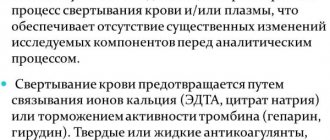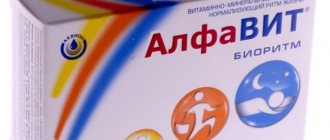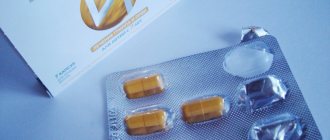Wessel Due F
A medicine of Italian origin with the seemingly bizarre name “Wessel Due F” is a natural substance obtained from the mucous membrane of the small intestine of a pig. This is a natural “mix” of mucopolysaccharides, 80% of which is the heparin-like fraction, and the remaining 20% is dermatan sulfate. The pharmacological effect of this drug (and its international nonproprietary name sounds like sulodexin) is one way or another connected with blood and blood vessels and is formed by summing up profibrinolytic (the ability to break down fibrin, which is the basis of blood clots), antithrombotic (everything is clear here), angioprotective (reducing the permeability of the walls blood vessels) and anticoagulant (preventing blood clotting) effects. The fast-flowing heparin-like fraction has a “kindred feeling” for antithrombin III, and the dermatan fraction, in turn, has an affinity for the heparin cofactor II, which “disarms” the most important ingredient of the blood coagulation system - thrombin. This, in a nutshell, is the mechanism of the anticoagulant action of Wessel Due F. Its antithrombotic effect develops due to the activation of the formation and release of prostacyclin (PGI2), a decrease in the concentration of fibrinogen in the blood, inhibition of activated factor X, etc.. The profibrinolytic effect of Wessel Due F is caused by an increase in the blood level of plasminogen, the precursor of the tissue activator plasmin, as well as a simultaneous decrease in the level of its inhibitor.
The angioprotective effect of the drug consists of the regeneration of the morphological and functional integrity of endothelial vascular cells, the normalization of the negative charge of the pores of the basal vascular membranes. Additionally, blood fluidity improves by reducing the content of triglycerides in it (the drug activates the enzyme lipoprotein lipase, which breaks down triglycerides that make up “bad” cholesterol). Due to its purely positive effect on the vascular bed, the drug is used for various diseases of blood vessels of any location, circulatory disorders, incl. caused by diabetes mellitus.
Wessel Due F is available in two dosage forms: capsules and solution for injection. The solution is administered both intramuscularly and intravenously (in the latter case, along with 150–200 ml of saline). At the beginning of the drug course, 1 ampoule of the drug is used daily for 15–20 days, then a transition is made to the oral form with a dosage frequency of 2 times a day, 1 capsule between meals for 30–40 days. The full course of treatment must be repeated at least 2 times a year. The attending physician may, at his discretion, change the dosage regimen of the drug.
Thrombophilia
The question of thrombophilia in the office of reproductive specialists arises almost daily. We tried to understand this difficult topic with Yulia Alekseevna Kikina
The fact is that now girls are very well-read, literate, they read a lot on forums, and all of them come as one with the question: “do I need to take a blood test for thrombophilia, when to retake D-Dimer, how much Clexane to inject?” People are so frightened by the concept of thrombophilia and afraid of the growth of d-Dimer that they are ready to monitor it almost daily, and all attempts to dissuade them from this are met with hostility.
Therefore, today I will dwell on this problem in more detail and will wait for your questions so that we can resolve everything with you.
At the RAHR scientific conference this year, I met a wonderful hematologist, Maria Alekseevna Vinogradova. She gave us an excellent lecture about thrombophilia, thrombosis and miscarriage, after which I wanted to tell this to everyone, all my colleagues and patients. Its main idea is that examinations should be carried out according to indications (!) and interpreted based on the medical situation, and not just looking at the results of reference values (i.e., differences in the result from normal values), and then therapy will be effective and safe, and the woman will no longer be in constant stress due to fear of growing d-Dimer levels, suffer from bruises from the continuous administration of anticoagulants and spend huge amounts of money on examinations.
So, briefly:
- THROMBOPHILIA IS NOT THROMBOSIS! This is a tendency to form thrombosis under unfavorable conditions, and the doctor’s task is to prevent the creation of these conditions. But this does not mean that a woman should constantly inject heparin drugs in order to “avoid the risk of thrombosis”; this is not justified. Firstly, because thrombophilia in most cases in patients is compensated and the body itself copes with all risks. And secondly, heparin drugs do not have a long-term effect; they only work when you inject them. If you have taken blood tests for thrombophilia, received changes in them (for example, a heterozygous PAI indicator, which happens to most) and decided a month before IVF to start fighting it by daily administration of Clexane or Wessel Due F - you are wasting your time and money ( note, considerable!). If your hemostasis is compensated, as a blood clotting test will tell us, then such prevention will not give you anything other than bruises on your stomach.
- Thrombophilia does not affect the success of IVF. Its impact is mainly associated with the risk of miscarriage.
- D-dimer increases during pregnancy NORMALLY! And it is not a criterion for prescribing anticoagulant therapy, nor is it a parameter that should be monitored during pregnancy. Its control is relevant for those in whom it was elevated before pregnancy. If d-dimer did not increase before pregnancy, there is no reason to worry about its increase during pregnancy.
- Who should be screened for hereditary thrombophilia? For those with a complicated obstetric history:
- 1 or more miscarriages over 10 weeks, provided that genetic causes of miscarriage are excluded;
- stillbirth of an apparently normal fetus, placental abruption in previous pregnancies;
- death of a baby after premature birth;
- severe gestosis (with high blood pressure, convulsions, bleeding disorders);
- delayed fetal development during pregnancy;
- three or more IVF failures.
- Testing for thrombophilia includes:
- antithrombin (it should not be low);
- protein C and protein S (their decrease is also pathological);
- factor V mutation (Leiden);
- prothrombin gene mutation (factor II);
- it is also important to exclude antiphospholipid syndrome (acquired thrombophilia) - antibodies to phospholipids, lupus anticoagulant;
- mixed form of thrombophilia - exclude an increase in homocysteine (it increases with folic acid deficiency).
- The incidence of hereditary thrombophilias and the risk of complications caused by them:
- Antithrombin deficiency occurs in only 0.1% of cases, but a fairly aggressive factor - the risk of complications is up to 50%.
- Deficiency of protein C and protein S - 0.5% - risk up to 10%.
- The heterozygous form of the Leiden mutation (one chromosome is normal, the other is altered) occurs in 4% of cases in the population and leads to complications in 6%.
- The homozygous Leiden mutation is the most dangerous of the thrombophilias; it can lead to miscarriages and thrombosis in 80% of cases. Fortunately, this is a fairly rare form of thrombophilia, only 0.002% in the population.
- Factor II (Prothrombin) in the heterozygous form is not very dangerous (3% occurrence and 3% risk of complications), in the homozygous form it is rare (0.01%), but dangerous for its complications (up to 30%).
- For those who are at risk, the recommended time frame for studying the hemostatic system (blood test for coagulation):
- before the protocol (1–2 days before the start of stimulation);
- 2–3 days before the puncture;
- the day after the puncture;
- 12–14 days after embryo transfer.
- 6–8 weeks of pregnancy;
- 12–13 weeks;
- 22–24 weeks (beginning of placental aging);
- 34–36 weeks;
- 2–3 days after birth.
- To date, there is no convincing evidence of the effectiveness of low-dose aspirin in preventing pregnancy loss. The use of low molecular weight heparin preparations (Clexan, Fraxiparin) significantly reduces the risk of pregnancy complications in hereditary thrombophilia and antiphospholipid syndrome. But prescriptions must be made by a doctor under the control of changes in the hemostasiogram, with the participation of a hematologist. Then the therapy will be really effective and safe.
During pregnancy, recommended timing of hemostasiogram monitoring:
Wessel Due F caps 250 LE x60
Wessel Due F caps 250 LE x60, ATX code: B01AB11 (Sulodexide) Active substance: sulodexide Rec.INN registered by WHO
Release form, composition and packaging
Soft gelatin capsules, brick-red in color, oval, the contents of the capsules are a white-gray suspension, a pinkish or pinkish-creamy tint is allowed.
1 caps.
sulodexide 250 LE*
Excipients: sodium lauryl sarcosinate - 3.3 mg, colloidal silicon dioxide - 3 mg, triglycerides - 86.1 mg.
Shell composition: gelatin - 55 mg, glycerol - 21 mg, sodium ethyl parahydroxybenzoate - 0.24 mg, sodium propyl parahydroxybenzoate - 0.12 mg, titanium dioxide (E171) - 0.3 mg, red iron oxide (E172) - 0.9 mg.
The solution for intravenous and intramuscular administration is light yellow or yellow in color, transparent.
1 amp.
sulodexide 600 LE*
Excipients: sodium chloride - 18 mg, water for injection - up to 2 ml.
Clinical and pharmacological group: Direct anticoagulant Pharmacotherapeutic group: Direct anticoagulant
pharmachologic effect
Direct acting anticoagulant. The active substance of Wessel Due F, sulodexide, is a natural product extracted and isolated from the mucous membrane of the small intestine of pigs. It is a natural mixture of glycosaminoglycans: heparin-like fraction with a molecular weight of 8000 daltons (80%) and dermatan sulfate (20%).
It has anticoagulant, antithrombotic, angioprotective and profibrinolytic effects.
The anticoagulant effect is due to the affinity for cofactor II of heparin, which inactivates thrombin.
The mechanism of antithrombotic action is associated with the suppression of activated factor X, increased synthesis and secretion of prostacyclin (PG I2), and a decrease in the level of fibrinogen in the blood plasma.
The profibrinolytic effect is due to an increase in the level of tissue plasminogen activator in the blood and a decrease in the content of its inhibitor.
The mechanism of angioprotective action is associated with the restoration of the structural and functional integrity of vascular endothelial cells, restoration of the normal density of the negative electrical charge of the pores of the vascular basement membrane.
In addition, the drug normalizes the rheological properties of the blood by reducing the level of triglycerides (since it stimulates the lipolytic enzyme - lipoprotein lipase, which hydrolyzes triglycerides that are part of LDL).
The effectiveness of the drug in diabetic nephropathy is determined by the ability of sulodexide to reduce the thickness of the basement membrane and the production of extracellular matrix by reducing the proliferation of mesangium cells.
Pharmacokinetics
Suction and distribution
After oral administration, sulodexide is absorbed from the small intestine. 90% of sulodexide is absorbed by the vascular endothelium, which exceeds its concentration in the tissues of other organs by 20-30 times.
Metabolism
Metabolized in the liver and kidneys. Unlike unfractionated heparin and low molecular weight heparins, sulodexide is not subject to desulfation, which leads to a decrease in antithrombotic activity and significantly accelerates elimination from the body.
Removal
Excreted by the kidneys 4 hours after administration.
After intravenous administration, urinary excretion is 50% after 24 hours, and 67% after 48 hours.
Indications
- angiopathy with an increased risk of thrombosis, incl. and after myocardial infarction,
- cerebrovascular accident, including the acute period of ischemic stroke and the period of early recovery,
- discirculatory encephalopathy caused by atherosclerosis, diabetes mellitus, arterial hypertension,
- vascular dementia,
- occlusive lesions of peripheral arteries of both atherosclerotic and diabetic origin,
- phlebopathy, deep vein thrombosis,
- microangiopathies (nephropathy, retinopathy, neuropathy),
— macroangiopathy in diabetes mellitus (diabetic foot syndrome, encephalopathy, cardiopathy),
- thrombophilic conditions, antiphospholipid syndrome (prescribed together with acetylsalicylic acid, as well as following low molecular weight heparins),
- treatment of heparin-induced thrombotic thrombocytopenia (since the drug does not cause or aggravate it).
ICD-10 codes
Dosage regimen
At the beginning of therapy, the drug is administered parenterally IM or IV (bolus or drip) 2 ml (1 ampoule) solution for injection (600 LE) for 15-20 days. To prepare a solution for intravenous administration, the contents of 1 ampoule are diluted in 150-200 ml of physiological solution.
Then they switch to taking the drug orally. Prescribe 1 capsule (250 LE) 2 times a day for 30-40 days.
Capsules are taken between meals.
The full course of treatment should be repeated at least 2 times a year.
Depending on the results of the clinical diagnostic examination of the patient, the dosage regimen may be changed.
Side effect
From the digestive system: nausea, vomiting, epigastric pain.
Allergic reactions: skin rash of various locations.
Local reactions: pain, burning, hematoma at the injection site.
Contraindications for use
- hemorrhagic diathesis and diseases accompanied by decreased blood clotting,
— I trimester of pregnancy,
- hypersensitivity to the components of the drug.
Use during pregnancy and breastfeeding
Use is contraindicated in the first trimester of pregnancy.
There is positive experience with the use of sulodexide in patients with type 1 diabetes mellitus in the second and third trimesters of pregnancy for the treatment and prevention of vascular complications, with the development of late toxicosis of pregnancy.
The drug Wessel Due F should be used during pregnancy in the second and third trimesters strictly under the supervision of a doctor.
Data on the use of the drug during lactation (breastfeeding) are not provided.
special instructions
When using the drug, monitoring of the coagulogram is necessary. At the beginning and end of treatment, it is advisable to determine the following indicators: aPTT, antithrombin III, bleeding time and clotting time. Wessel Due F increases normal APTT values by approximately 1.5 times.
Impact on the ability to drive vehicles and operate machinery
The drug does not affect the ability to drive vehicles or operate machinery.
Overdose
Symptoms: Bleeding or bleeding.
Treatment: discontinuation of the drug, symptomatic therapy if necessary.
Drug interactions
There are no clinically significant interactions between Wessel Due F and other drugs.
When using sulodexide, it is not recommended to simultaneously use anticoagulants (direct and indirect) and antiplatelet agents.
Storage conditions and periods
List B. The drug should be stored out of the reach of children at a temperature not exceeding 30°C. Shelf life: 5 years.
Conditions for dispensing from pharmacies The drug is dispensed with a prescription.



